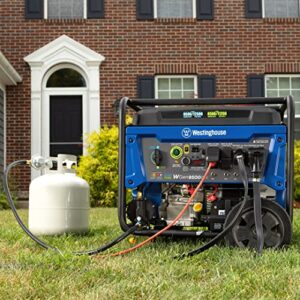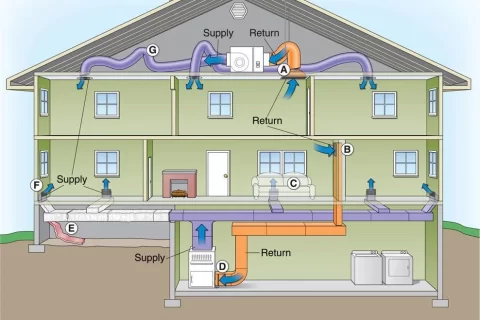Backup Power Solutions: Batteries, Generators, and More
Did you know that nearly 70 million Americans experience power outages each year? Having reliable AC backup power options is crucial for keeping your home and devices running smoothly during these times. From portable generators to battery backups, there are various solutions to consider. Each option, such as a backup power system or standby generator, has its pros and cons, making it essential to choose what fits your needs best. Understanding these choices can save you from inconvenience and potential damage to your electronics. This guide will explore the top AC backup power options available today, helping you make an informed decision. Prepare yourself for unexpected outages and ensure your comfort with the right backup solution.
Key Takeaways
-
Explore different backup power options like batteries and generators to find what fits your needs best.
-
When selecting a system, consider factors such as power requirements, space, and frequency of use.
-
Evaluate costs not only for the initial purchase but also for installation and maintenance over time.
-
Follow installation tips to ensure safety and efficiency when setting up your backup power system.
-
Regular maintenance can extend the lifespan of your backup systems, so schedule routine checks.
-
Portable power stations offer flexibility; assess your specific needs before investing in one.
Understanding Backup Power Options
Definition
Backup power options are systems that provide electricity during outages. They ensure essential appliances and devices remain functional. This is crucial for safety and comfort. Power outages can happen due to storms, equipment failure, back or other emergencies. Having a reliable backup power solution protects homes and businesses from disruptions.
Evolution of Backup Power
Backup power solutions have evolved significantly over the years. Traditional generators were the mainstay for many years. These units run on gasoline or diesel fuel. They can provide substantial energy but require regular maintenance.
Modern technology has introduced battery systems as a viable alternative. These backup power systems are quieter and more efficient. They store energy from the grid or renewable sources like solar panels. This shift allows for cleaner energy use and reduces reliance on fossil fuels. Many people now prefer these affordable power options back for their convenience and sustainability.
Solar Energy Integration
ar energy plays a vital role in home backup power solutions. Homeowners can install solar panels to harness sunlight. This energy can charge batteries during the day. When the sun sets or during a blackout, these batteries supply power back to the home.
Integrating solar with battery storage creates a powerful backup power plan. It enables homes to operate independently from the grid during outages. This system also promotes energy independence, back reduces electricity bills over time.
Types of Backup Power Systems
Several types of backup power sources exist today:
-
Portable Generators: These are easy to move and suitable for short-term use.
-
Standby Generators: These connect directly to a home’s electrical system and start automatically during an outage.
-
Battery Backup Systems: These store electricity for later use, often paired with solar panels.
Each type has its pros and cons depending on size, energy needs, budget considerations, and back.
Key Considerations
Choosing a backup power solution involves several factors:
-
Size: Assess your energy requirements to determine how much capacity you need.
-
Type: Decide between generators or battery systems based on your preferences.
-
Price: Budget accordingly, as costs can vary widely among different systems.
-
Years of Use: Consider how long you plan to rely on the system before making a purchase.
Comparing Batteries and Generators
Operational Mechanisms
Batteries store electrical energy for later use. They convert chemical energy into electricity through electrochemical reactions. This process occurs in various types of batteries, back including solar batteries designed for solar generator systems.
Generators, on the other hand, produce electricity by converting mechanical energy into electrical energy. They often run on fuels like gas, diesel, or propane. Home generators can be permanent installations or portable units. Standby generators automatically activate during power outages, while portable generators require manual setup.

Environmental Impact
Battery backups are generally more environmentally friendly than fuel-powered generators. Batteries produce no emissions during operation. This makes them a cleaner option for homes looking to reduce their carbon footprint.
Generators emit greenhouse gases due to their reliance on fossil fuels. Natural gas generators are less harmful than diesel ones but still contribute to air pollution. The environmental impact of each system depends on fuel type and usage frequency.
Cost-Effectiveness
The initial cost of battery systems can be high. However, they offer long-term savings. Solar batteries can be charged using solar panels, reducing electricity bills over time.
In contrast, fuel-powered generators have lower upfront costs but higher ongoing expenses. Fuel prices fluctuate, affecting overall costs. Maintenance is also required for generators, adding to their expense.
Duration of Power Supply
Batteries typically provide shorter power supply durations compared to generators. A standard battery system can last from a few hours to several days, depending on capacity and usage. For example, a typical home battery may support basic appliances for about 24 hours.
Generators can run indefinitely as long as fuel is available. A natural gas generator connected to the grid can operate continuously during an outage. Propane and diesel generators also supply power based on fuel availability.
Summary
Both batteries and generators serve vital roles in backup power systems. Each has unique advantages and disadvantages. Batteries offer clean energy with limited duration but high initial costs. Generators provide longer-lasting power but at the expense of higher emissions and fluctuating fuel costs.
Choosing between these options depends on individual needs and circumstances. Homeowners must consider factors like budget, environmental impact, and how long they need backup power during outages.
Selecting the Right Backup System
Assessing Needs
Assess your household’s power consumption. Identify which appliances and devices are essential during an outage. This includes refrigerators, medical equipment, and heating or cooling systems.
Determine how often outages occur in your area. Frequent outages may require a more robust backup system. Backup options can vary widely in capacity. Choose one that meets your needs without overspending.
Evaluating Space
Evaluate the available space for installation. Some systems require more room than others. Generators need adequate ventilation and clearance. Batteries can be more compact but still require proper placement.
Consider compatibility with existing energy sources. Some homes may have solar panels or other renewable energy systems. Ensure that the backup system you choose integrates well with these sources.
Understanding Regulations
Check local regulations regarding backup systems. Some areas have specific codes for generator installations. Compliance is crucial to avoid fines or safety issues.
Incentives may also influence your choice of a backup system. Local governments sometimes offer rebates for installing energy-efficient systems. Research available incentives to help offset costs.
Transfer Switch Options
A transfer switch is essential for safely connecting a generator to your home’s electrical panel. This device prevents backfeed into the grid, protecting utility workers and your equipment.
Two main types of transfer switches exist: manual and automatic. Manual switches require user intervention during an outage. Automatic switches detect power loss and activate the generator without user input.
Wall-Mounted Systems
Wall-mounted battery systems are another option for backup power. These units can be installed indoors, saving outdoor space. They store energy from the grid or renewable sources for use during outages.
Such systems often come with smart technology features. Users can monitor their energy usage through an app on their phones. This real-time data helps manage power consumption efficiently.
Cost Considerations for Backup Power
Upfront Costs
Initial investment costs play a significant role in choosing backup power systems. Battery backups typically range from $5,000 to $15,000 depending on capacity and brand. This price includes installation fees. Generators generally have lower upfront costs, averaging between $2,000 and $6,000. However, the price can increase with larger models or additional features.
Battery systems often require less maintenance than generators. This factor can influence long-term cost efficiency. Despite higher initial costs, battery backups can save money over time through reduced fuel expenses.
Long-Term Expenses
Long-term expenses vary greatly between battery backups and generators. Generators need fuel to operate, which adds ongoing costs. Fuel prices fluctuate, impacting overall expenses. For example, if a generator runs for 10 hours a week at $3 per gallon, it could cost around $1,500 annually just for fuel.
Battery systems usually incur fewer ongoing costs. They rely on electricity for charging rather than fuel. Homeowners may also benefit from lower electricity rates during off-peak hours if they charge batteries then. Over time, this can lead to significant savings.
Financing Options
Financing options make backup power systems more accessible. Many companies offer payment plans that allow homeowners to pay in installments. This approach reduces the burden of upfront costs.
e states provide rebates for installing energy-efficient backup power solutions. These rebates can cover a portion of the initial investment for battery systems or generators. Homeowners should check local programs to find potential savings.
Tax credits are another option available in certain areas. These incentives can further reduce the overall cost of backup power installations.
Installation Tips for Backup Systems
Hire Professionals
Certified professionals should handle the installation of backup power systems. They have the expertise to ensure everything is set up correctly. Mistakes during installation can lead to system failures or safety hazards. Professionals also understand local building codes and regulations. This knowledge helps avoid fines and ensures compliance.
Homeowners can benefit from professional advice on the best equipment for their needs. Experts can recommend suitable generators and battery systems based on home size and energy requirements. They may also offer guidance on maintaining the system after installation.
Permits and Inspections
Before installation, homeowners must identify necessary permits and inspections. Local governments often require permits for electrical work, especially for backup systems. These permits ensure that installations meet safety and code standards.
It is crucial to check with local authorities about specific requirements. Some areas may have additional rules regarding generator placement or noise levels. Homeowners should obtain all required permits before starting any work. Failure to do so can result in delays or costly fines.
Optimal Placement
Choosing the right location for batteries and generators is essential for efficiency and safety. Generators should be placed outdoors, away from windows and doors. This prevents exhaust fumes from entering the home. The area should be well-ventilated to allow proper airflow around the generator.
Batteries need a dry, cool place away from direct sunlight. Excess heat can reduce battery life and performance. Consider placing batteries in a basement or utility room with controlled temperatures. Ensure there is enough space around them for maintenance access.
Maintenance Considerations
Regular maintenance is vital for backup systems to function effectively. Schedule routine checks on both generators and batteries. This includes testing the generator under load conditions to ensure it operates correctly.
Homeowners should also clean battery terminals periodically to prevent corrosion. Keeping connections tight ensures optimal performance during outages. Follow manufacturer guidelines for maintenance schedules and procedures.
Safety Measures
Safety should always be a priority during installation and operation of backup systems. Install carbon monoxide detectors near sleeping areas when using generators. These detectors alert homeowners to dangerous gas levels.
Keep fire extinguishers accessible in case of emergencies related to electrical systems. Educate family members about safe operating procedures for backup power systems.
Maintenance and Lifespan Insights
Routine Maintenance
Routine maintenance is crucial for standby generators. Regular checks can extend the lifespan of these systems. Owners should inspect oil levels, air filters, and battery connections every month.
Cleaning the generator helps prevent dirt buildup. This dirt can cause overheating and damage. Fuel quality is also important. Use fresh fuel to avoid issues with starting and running.
Annual professional servicing is recommended. Technicians can perform in-depth inspections. They check electrical connections, coolant levels, and overall system performance. This service can help identify issues before they become serious problems.
Lifespan Expectations
Battery backups typically last between 5 to 15 years. Their lifespan depends on usage patterns and environmental conditions. In contrast, traditional generators can last longer, often up to 20 years or more with proper care.
Battery systems may have shorter lifespans but require less maintenance. They are often quieter during operation, making them suitable for residential areas. Traditional generators, while durable, produce more noise and may require more frequent servicing.
Benefits of Battery Systems
Battery backup systems offer several advantages over traditional generators. They operate quietly, which reduces noise pollution in neighborhoods. This feature makes them appealing for homes near busy streets or schools.
Lower maintenance needs are another advantage. Battery systems do not require regular oil changes or fuel checks like conventional generators do. This simplicity saves time and effort for homeowners.
Battery systems also provide reliable power during outages. They quickly supply energy when utility power fails. Many models have built-in monitoring features that alert users to potential issues.
Warranties and Pricing
Most battery backup products come with a year warranty, which covers defects in materials and workmanship. These warranties vary by manufacturer, so it’s essential to read the fine print.
Pricing for backup power options varies widely based on capacity and features. Battery systems generally have lower upfront costs than larger generators but may require replacements sooner.
Factors influencing pricing include brand reputation, storage capacity, and additional features like smart technology integration. Users should weigh the pros and cons of each option based on their specific needs and environment.
Choosing the Right Battery Backup
Brand Options
Many battery backup systems are available today. Popular brands include Tesla, LG, and Generac. Each offers different features and benefits. Tesla’s Powerwall is known for its high capacity and integration with solar systems. LG Chem provides compact options suitable for smaller homes. Generac focuses on reliable power solutions during outages.
Researching these brands helps narrow down choices. Look at customer reviews and expert ratings. Understanding each brand’s strengths can guide decisions.
Capacity Ratings
Capacity ratings indicate how much energy a backup battery can store. This rating is crucial for matching a battery backup system to household energy needs. Most home battery backups range from 5 kWh to 20 kWh. A larger capacity is ideal for homes with higher energy consumption.
Assessing your household’s energy use is vital. Calculate daily energy requirements based on appliances and devices. For example, a refrigerator may use about 1 kWh per day, while heating or cooling systems can consume more. Knowing this helps determine the size of the home battery backup system needed.
Warranty and Support
Warranties vary among backup battery manufacturers. Many offer warranties between 5 to 10 years, covering defects and performance issues. A longer warranty often indicates confidence in product durability.
Customer service support also matters when selecting a home power backup system. Good support can assist with installation and troubleshooting. Check if the manufacturer has accessible contact options like phone or online chat.
Installation Considerations
Installation plays a key role in using a home battery backup system effectively. Some systems require professional installation, while others allow DIY setups. Professional installation ensures safety and optimal performance.
Consider local regulations regarding installations too. Certain areas may have specific codes that must be followed. Checking these beforehand saves future headaches.
Cost Analysis
The price of home battery storage varies widely based on brand, capacity, and features. Basic models may start around $5,000, while advanced systems can exceed $15,000. Additional costs for installation can also add up.
Budgeting upfront is essential when choosing a home backup power solution. Weigh initial costs against potential savings on electricity bills over time.
Evaluating Portable Power Stations
Definition
Portable power stations are compact devices that store energy for later use. They come equipped with various outlets to power different devices. Their primary uses include charging laptops, powering small appliances, and providing electricity during emergencies.
These units often feature lithium-ion batteries. This technology allows for efficient energy storage and quick charging times. Some models even integrate solar panels, enabling users to harness solar energy for a renewable power source.
Capacity Comparison
Portable power stations differ significantly from traditional backup systems. Traditional generators often run on liquid propane or gasoline and provide higher wattage. They can power entire homes or larger appliances but require more setup and maintenance.
In contrast, portable power stations offer lower kilowatt capacities but excel in versatility. Most portable units range from 200 to 3000 watts. Users can select models based on their specific power needs. For example, a unit with 500 watts can charge several laptops simultaneously while a higher capacity model can run a small refrigerator.
Portability Advantages
Portability is one of the major advantages of these power sources. Users can easily transport them to various locations. This feature makes them ideal for outdoor activities like camping or tailgating.
Setup is usually straightforward. Most units simply need to be plugged in to charge, which can take just a few hours. In emergencies, they can be quickly deployed without complicated connections to an electrical panel.
Consider the following benefits of portable power stations:
-
Ease of transport: Many models weigh less than 50 pounds.
-
User-friendly: Simple controls allow anyone to operate them.
-
Multiple charging options: Users can charge via wall outlets, car chargers, or solar panels.
These features make portable power stations suitable for both recreational use and emergency preparedness.
Closing Thoughts
Backup power options are essential for keeping your home running smoothly during outages. Whether you choose batteries, generators, or portable power stations, knowing the pros and cons helps you make the right choice. Cost, installation, and maintenance are key factors that can impact your decision.
Take control of your power needs today. Assess your situation and invest in a backup system that suits your lifestyle. Don’t wait for the next outage to realize the importance of reliable power. Explore your options and ensure peace of mind for you and your family.
Frequently Asked Questions
What are the main types of backup power options?
The primary backup power options include batteries, generators, and portable power stations. Each has unique benefits, such as portability or longer run times, catering to different needs.
How do batteries compare to generators for backup power?
Batteries provide silent, clean energy and are ideal for short outages. Generators offer higher power output for extended periods but can be noisy and require fuel.
What should I consider when selecting a backup system?
Consider your power needs, installation space, budget, and maintenance requirements. Assess how long you need power during an outage to choose the right system.
How much does a backup power system typically cost?
Costs vary widely based on capacity and type. Battery systems can start around $500, while generators may range from $1,000 to several thousand dollars depending on features.
What are some installation tips for backup systems?
Ensure proper ventilation for generators. Follow manufacturer guidelines closely. It’s often best to hire a professional for installation to ensure safety and compliance with local codes.
How can I maintain my backup power system?
Regularly check battery levels and connections. For generators, change oil and filters as recommended. Schedule annual inspections to keep systems running efficiently.
What should I look for in a portable power station?
Look for capacity, output options, weight, and charging time. Consider additional features like solar compatibility for added convenience and sustainability.


